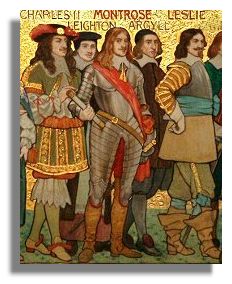 Graham was brought up at Kincardine Castle and succeeded his father as 5th earl of Montrose, November 14, 1626. His mother was Margaret, eldest daughter of William Ruthven, 1st earl of Gowrie. The young Montrose was educated at St. Andrews University.
Graham was brought up at Kincardine Castle and succeeded his father as 5th earl of Montrose, November 14, 1626. His mother was Margaret, eldest daughter of William Ruthven, 1st earl of Gowrie. The young Montrose was educated at St. Andrews University.
The illustration here (from a frieze in the Scottish National Portrait Gallery) shows Montose with his contemporaries - James Leslie (the Covenanter who would eventually defeat him), the 8th Earl of Argyll (created 1st Marquis of Argyll by King Charles I but who lost his head on the scaffold at the Restoration of King Charles II), Robert Leighton (Archbishop of Glasgow who advocated compromise and "comprehension" between Presbyterian and Episcopalians).
In 1637 he took an active part in drawing up the National Covenant at Greyfriars' Kirkyard in Edinburgh, after King Charles I attempted to introduce an episcopal "Book of Common Prayer" which was seen as an attempt to anglicise Scotland and the church. But Montrose soon found himself in complete antagonism to the extremist leaders of Presbyterianism and became in Scotland the foremost champion of the crown against the Covenanters. In 1643 he was imprisoned for five months in Edinburgh Castle.
In 1644, the Scots army entered England in alliance with the English Parliament and the Puritans against King Charles I. Scotland had not been in open rebellion until that time. Montrose obtained a commission as Lieutenant-general in Scotland from the king at Oxford, passed back into Scotland in disguise and raised the dis-affected and largely Catholic clans of the Highlands, plus some Irish soldiers, on behalf of the king.
 At the head of a small force, barely numbering 2,000 men, Montrose, now elevated to marquess by the king, conducted in the Highlands a brilliant series of campaigns. With skill and leadership, he won victory after victory over forces sometimes three times as numerous as his own at Tippermuir, September 1, 1644, Inverlochy, February 2, 1645, and Kilsyth, August 15, 1645 (where for once he had 5,000 men). This victory seemed to place the Lowlands at his mercy, but when he advanced further into the Borders, the clansmen dispersed. He had with him less than 1,000 men when he was surprised and his troops were cut to pieces by a superior force under David Leslie at Philiphaugh near Selkirk, September 13, 1645. Montrose had arrived late for the battle, when it was already lost, but had to be dissuaded from entering the fray by his companions.
At the head of a small force, barely numbering 2,000 men, Montrose, now elevated to marquess by the king, conducted in the Highlands a brilliant series of campaigns. With skill and leadership, he won victory after victory over forces sometimes three times as numerous as his own at Tippermuir, September 1, 1644, Inverlochy, February 2, 1645, and Kilsyth, August 15, 1645 (where for once he had 5,000 men). This victory seemed to place the Lowlands at his mercy, but when he advanced further into the Borders, the clansmen dispersed. He had with him less than 1,000 men when he was surprised and his troops were cut to pieces by a superior force under David Leslie at Philiphaugh near Selkirk, September 13, 1645. Montrose had arrived late for the battle, when it was already lost, but had to be dissuaded from entering the fray by his companions.
Finding now that the royalist cause in Scotland was hopelessly lost, Montrose was ordered by the king to abandon his efforts and he escaped abroad to Norway. But in 1649, after being shocked when the English Parliament beheaded Charles 1, he resolved on one more desperate effort on behalf of Charles II. In April, 1650, he landed in Caithness, but few men rallied to his standard and he had lost many of his men in a shipwreck in Orkney. His small force was defeated at Carbisdale on 27 April, 1650. He was betrayed by MacLeod of Assynt for the then huge sum of £25,000 and was delivered into the hands of the Scots government. He was taken to Edinburgh and, without trial, was sentenced to be hanged and dismembered as a traitor. The capital sentence was carried out in the Grassmarket, Edinburgh, on May 21, 1650. Eleven years later the remains of the "great marquess" were buried in St. Giles, where a monument was erected to him in 1888, inscribed:
"Scotland's glory, Britain's pride,
As brave a subject as ere for monarch dy'd
Kingdoms in Ruins often lye
But great Montrose's Acts will never dye"



